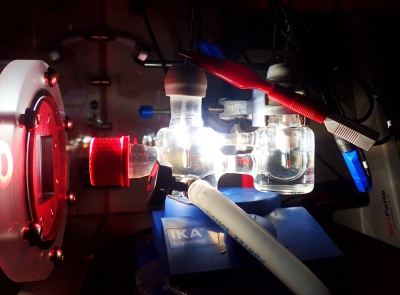 Alanna Ketler – The sun is a big burning ball of fire and thus, energy. Really, everything is energy. We already know that it is the light and warmth of the sun that gives life to every living thing on this planet. We have already seen an example of how the sun’s energy can be utilized to create power with the rapidly increasing use of solar panels, but researchers from St. John’s College, University of Cambridge, have now discovered a new way to utilize energy from the sun and turn it into fuel. Yes fuel — the type of fuel that could directly compete with fossil fuels.
Alanna Ketler – The sun is a big burning ball of fire and thus, energy. Really, everything is energy. We already know that it is the light and warmth of the sun that gives life to every living thing on this planet. We have already seen an example of how the sun’s energy can be utilized to create power with the rapidly increasing use of solar panels, but researchers from St. John’s College, University of Cambridge, have now discovered a new way to utilize energy from the sun and turn it into fuel. Yes fuel — the type of fuel that could directly compete with fossil fuels.
The researchers used semi-artificial photosynthesis to explore new ways to produce and store solar energy. Using natural sunlight to separate hydrogen and oxygen including the use of a combination of biological components and human made technologies.
This research could revolutionize the way we are currently utilizing the sun for renewable energy production. Their method was able to absorb even more solar light than the natural process of photosynthesis. A paper, published in the journal Nature Energy described how the researchers were able to develop this process of unassisted, solar driven water splitting.
One of the authors of the study and PhD student at St. John’s college, Katarzyna Sokól said, “Natural photosynthesis is not efficient because it has evolved merely to survive so it makes the bare minimum amount of energy needed — around 1-2 percent of what it could potentially convert and store. “
One of the keys to this process is an ancient enzyme known as hydrogenase.
“Hydrogenase is an enzyme present in algae that is capable of reducing protons into hydrogen,” Sokól added.
During evolution this process has been deactivated because it was necessary for survival but we successfully managed to bypass the inactivity to achieve the reaction we wanted — splitting water into hydrogen and oxygen.”
The process of mimicking photosynthesis in order to collect and store energy is something that scientists have been experimenting with for years. However, according to Sokól, the earlier technologies are not capable of scaling up to industrial models for a myriad of different reasons — either they are too expensive, or inefficient of use materials could also pose a risk to the environment.
The team took the approach to create an electrochemical cell, similar to a traditional battery, but based on the light-collecting biochemistry of a process called photosystem II. This was able to provide the necessary voltage that is required for the hydrogenase enzyme to do do it’s job and reduce the amount of hydrogen in water so that it can separate from oxygen and become the gas it was born to be.
Although this process may sound simple, connecting artificial systems with natural and organic processes has proved to be quite challenging.
“This work overcomes many difficult challenges associated with the integration of biological and organic components into inorganic materials for the assembly of semi-artificial devices and opens up a toolbox for developing future systems for solar energy conversion,” says, Erwin Resner, author and laboratory head.
There is much more research that needs to be done, but this is a huge and important step towards being able to fully utilize this method for an alternate fuel source.
“This could be a great platform for developing solar technologies. The approach could be used to couple other reactions together to see what can be done, learn from these reactions and then build synthetic, more robust pieces of solar energy technology,” says Sokól.
“It’s exciting that we can selectively choose the processes we want, and achieve the reaction we want which is inaccessible in nature. This could be a great platform for developing solar technologies. The approach could be used to couple other reactions together to see what can be done, learn from these reactions and then build synthetic, more robust pieces of solar energy technology,” she added.
Final Note
While this is certainly a plus in the direction of moving toward new energy systems, these technologies have advanced counterparts in the realm of zero-point energythat can make an even greater impact on humanity, without the need for sunlight.
The challenge? It has often been said that if ‘free energy’ like technologies come out prior to humanity shifting their consciousness enough to truly handle these technologies, we will in essence use them in the exact same way we do now: patent them, limit them and then charge people extensively for energy. This does not help to free the population, but only keeps it enslaved, and abundance limited.
Much Love, Alanna
SF Source Collective Evolution Sep 2018
